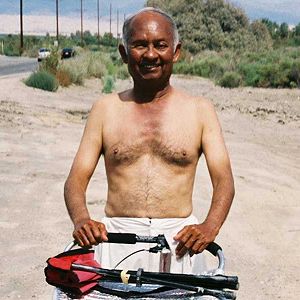Hotter than Death Valley?
A Summer Walk Around the Salton Sea
Site Navigation
Day 3
One of my self-imposed rules was not to start my daily walk before 9:00 AM. I wanted to make sure that I would have to walk between noon and four, the hottest part of the day. After I returned home, I found that the high temperatures during the week were between 106°F and 110°F, and the corresponding humidity 40% to 50%. This meant a heat index range of roughly 130 to 140. Even at 9 AM, the temperature of 95°F with 70% humidity resulted in a heat index of 124. It felt almost as hot at nine in the morning as three in the afternoon.
Heat Training

Dinesh's multi-colored layered look. One needs to be fashionable even during training.
I am often asked how I am able to walk in such extremely hot weather. The answer in one word is pre-acclimatization. The human body is amazingly adaptable, provided it is given sufficient time to adapt. It won't fare well if it is just thrown into an extreme environment. It is not possible to train one's body to use less water, but it is possible to make the sweat glands work more efficiently. Evaporating sweat cools the body and the acclimatization process involves subjecting the body to profuse sweating. This can be accomplished either by exercising in a desert environment or by exercising in more moderate climates wearing layers of clothing. About 15 sessions of 90 to 120 minutes each, in the month preceding the exposure, are required for optimum acclimatization.
By the end of my training sessions, I had acclimatized to such an extent that I did not feel any ill effects in spite of my body temperature reaching 104°F. Another way to acclimatize is to sit in a sauna for longer and longer periods of time. However, I personally like acclimatizing outdoors; it allowed me to experience conditions I would encounter during my planned walk.

Dinesh appears to be part Indian and part African.
Even though I was under an umbrella, my uncovered skin turned several shades darker. I can't quantify how much sweat I poured, but it must have been considerable. I was wearing a talking watch that had two tiny holes in the back for the sound. The watch stopped working on the third day. Later, when I took it to a jeweler, I was told that the mechanism was rusted due to excessive moisture.
I was in excellent spirits after feeling no ill effects yesterday. I was reasonably comfortable in the heat, but I thanked my stars after going over an unavoidable stretch of shoulder full of broken glass. Even though I had practiced replacing a punctured tube at home, I wasn't sure if I could have done it in the extreme heat of the desert.
After two and a half days along the highway, I was finally on the streets of the town of Calipatria. Each street's shoulder was dirt, very uneven and rutted, and I had to walk on the street itself. Though the traffic was light, it did force me onto the shoulder from time to time. On the plus side, a couple of farms along the way provided me with an opportunity for a shady rest stop.

A big shady spot? Not really. The big ditch in the back limits the usable space.
We spent the night in a motel in Calipatria. The motel was quite good and our corner room had a refrigerator and a microwave oven. The motel provided breakfast, but the town had no restaurants. I remembered eating microwaved pizza in a mini-mart when I was kayaking here five years ago. The same mini-mart was still the only game in town. This time, however, we had bought along freeze-dried dinners, soups, tortillas, etc., and were able to enjoy three good dinners right in our room.
What, you may wonder, did Joy do to occupy herself during the day while I walked? She had brought plenty of reading material, crossword puzzles and even a couple of jigsaw puzzles. She also had a hand-held GPS receiver with which she hoped to find some geocaches.
Geocaching is basically a hi-tech scavenger hunt. One needs a computer at home, with Web access, to log onto the web site www.geocaching.com, and a handheld GPS receiver. A GPS receiver is a device that uses a system of orbiting satellites to determine its location, stated in latitude and longitude. The goal is to find locations where cache boxes are hidden. The caches usually contain some inexpensive trinkets, but the thrill is in the searching and in the excitement of the find. The hobby has really taken off since its beginning in April 2000. Currently, there are over 200,000 active caches worldwide. The majority of the caches are in the U.S., but even Antarctica has 12.
Joy, unfortunately, had one problem. By the time she dropped me off around 9 AM, it was already too hot. Unlike me, she didn't need to and hadn't trained for heat and found the heat quite oppressive. Still, she bravely ventured out and found a few geocaches, including the "Old glory as you've never seen it!" cache in Calipatria. The town is located at an elevation of 184 feet below sea level and is the lowest town in the Western Hemisphere. The geocache hunt led Joy to a small park where she found, near the cache site, the world's tallest flagpole, 184 feet tall.

|

Courtesy of Ken Williams
|
Site Navigation




